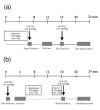Myocardial first-pass perfusion cardiovascular magnetic resonance: history, theory, and current state of the art
- PMID: 18442372
- PMCID: PMC2387155
- DOI: 10.1186/1532-429X-10-18
Myocardial first-pass perfusion cardiovascular magnetic resonance: history, theory, and current state of the art
Abstract
In less than two decades, first-pass perfusion cardiovascular magnetic resonance (CMR) has undergone a wide range of changes with the development and availability of improved hardware, software, and contrast agents, in concert with a better understanding of the mechanisms of contrast enhancement. The following review provides a perspective of the historical development of first-pass CMR, the developments in pulse sequence design and contrast agents, the relevant animal models used in early preclinical studies, the mechanism of artifacts, the differences between 1.5T and 3T scanning, and the relevant clinical applications and protocols. This comprehensive overview includes a summary of the past clinical performance of first-pass perfusion CMR and current clinical applications using state-of-the-art methodologies.
Figures







Similar articles
-
Adenosine stress cardiovascular magnetic resonance with variable-density spiral pulse sequences accurately detects coronary artery disease: initial clinical evaluation.Circ Cardiovasc Imaging. 2014 Jul;7(4):639-46. doi: 10.1161/CIRCIMAGING.113.001584. Epub 2014 Apr 23. Circ Cardiovasc Imaging. 2014. PMID: 24759900 Free PMC article.
-
Cardiovascular magnetic resonance phase contrast imaging.J Cardiovasc Magn Reson. 2015 Aug 9;17(1):71. doi: 10.1186/s12968-015-0172-7. J Cardiovasc Magn Reson. 2015. PMID: 26254979 Free PMC article. Review.
-
An isolated perfused pig heart model for the development, validation and translation of novel cardiovascular magnetic resonance techniques.J Cardiovasc Magn Reson. 2010 Sep 17;12(1):53. doi: 10.1186/1532-429X-12-53. J Cardiovasc Magn Reson. 2010. PMID: 20849589 Free PMC article.
-
Multicenter evaluation of dynamic three-dimensional magnetic resonance myocardial perfusion imaging for the detection of coronary artery disease defined by fractional flow reserve.Circ Cardiovasc Imaging. 2015 May;8(5):e003061. doi: 10.1161/CIRCIMAGING.114.003061. Circ Cardiovasc Imaging. 2015. PMID: 25901043
-
Advances in parametric mapping with CMR imaging.JACC Cardiovasc Imaging. 2013 Jul;6(7):806-22. doi: 10.1016/j.jcmg.2013.05.005. JACC Cardiovasc Imaging. 2013. PMID: 23845576 Free PMC article. Review.
Cited by
-
Comprehensive review of artifacts in cardiac MRI and their mitigation.Int J Cardiovasc Imaging. 2024 Oct;40(10):2021-2039. doi: 10.1007/s10554-024-03234-4. Epub 2024 Sep 18. Int J Cardiovasc Imaging. 2024. PMID: 39292396 Review.
-
The role of stress cardiac magnetic resonance in women.J Nucl Cardiol. 2016 Oct;23(5):1036-1040. doi: 10.1007/s12350-016-0597-x. Epub 2016 Jul 25. J Nucl Cardiol. 2016. PMID: 27457529 Review.
-
Quantitative myocardial first-pass cardiovascular magnetic resonance perfusion imaging using hyperpolarized [1-13C] pyruvate.J Cardiovasc Magn Reson. 2018 Nov 12;20(1):73. doi: 10.1186/s12968-018-0495-2. J Cardiovasc Magn Reson. 2018. PMID: 30415642 Free PMC article.
-
Recommendations for cardiovascular magnetic resonance in adults with congenital heart disease from the respective working groups of the European Society of Cardiology.Eur Heart J. 2010 Apr;31(7):794-805. doi: 10.1093/eurheartj/ehp586. Epub 2010 Jan 11. Eur Heart J. 2010. PMID: 20067914 Free PMC article.
-
Non-ECG-gated myocardial perfusion MRI using continuous magnetization-driven radial sampling.Magn Reson Med. 2014 Dec;72(6):1620-8. doi: 10.1002/mrm.25074. Epub 2014 Jan 17. Magn Reson Med. 2014. PMID: 24443160 Free PMC article.
References
-
- Hesse B, Tagil K, Cuocolo A, Anagnostopoulos C, Bardies M, Bax J, Bengel F, Busemann Sokole E, Davies G, Dondi M, Edenbrandt L, Franken P, Kjaer A, Knuuti J, Lassmann M, Ljungberg M, Marcassa C, Marie PY, McKiddie F, O'Connor M, Prvulovich E, Underwood R, van Eck-Smit B. EANM/ESC procedural guidelines for myocardial perfusion imaging in nuclear cardiology. Eur J Nucl Med Mol Imaging. 2005;32(7):855–897. doi: 10.1007/s00259-005-1779-y. - DOI - PubMed
-
- Zoghbi GJ, Iskandrian AE. Coronary artery disease: pharmacological stress. In: Zaret BL, Beller GA, editor. Nuclear Cardiology: State of the Art and Future Directions. 3. Philadelphia, PA: Mosby; 2005. pp. 233–253.
-
- Hachamovitch R, Berman DS, Shaw LJ, Kiat H, Cohen I, Cabico JA, Friedman J, Diamond GA. Incremental prognostic value of myocardial perfusion single photon emission computed tomography for the prediction of cardiac death: differential stratification for risk of cardiac death and myocardial infarction. Circulation. 97(6):535–543. Feb 17 1998. - PubMed
-
- Atkinson DJ, Burstein D, Edelman RR. First-pass cardiac perfusion: evaluation with ultrafast MR imaging. Radiology. 1990;174(3 Pt 1):757–762. - PubMed
Publication types
MeSH terms
Substances
Grants and funding
LinkOut - more resources
Full Text Sources
Other Literature Sources
Medical
Miscellaneous

